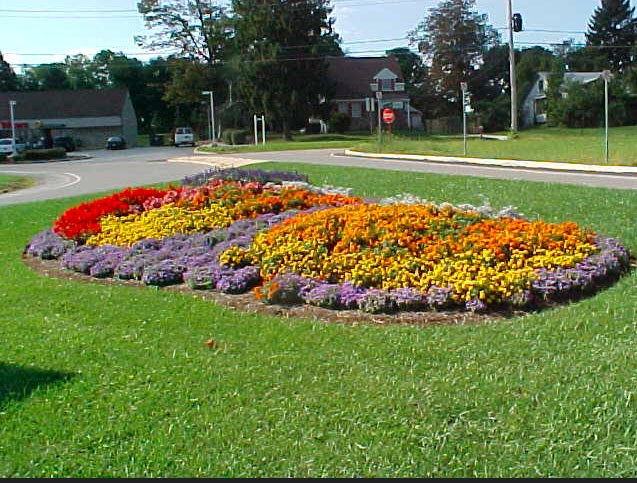Posted: May 5, 2020
Can Pennsylvania roadsides become canvases for vibrant arrays of wildflowers? The Pennsylvania Department of Transportation (PennDOT) hopes so!

A large floral display at a road intersection
In 2017, PennDOT developed their Pollinator Habitat Plan in support of Federal and State efforts to combat pollinator declines. The plan aims to establish floral resources along strategically selected roadsides to support pollinators, while minimizing vehicle-pollinator conflicts. To achieve this goal, PennDOT has partnered with a team of researchers to understand how to best establish and assess these habitats.
One Penn State researcher aiding in these efforts is Dr. Carolyn Mahan of Penn State Altoona. Dr. Mahan believes that the transformation of Pennsylvania roadsides into lush, pollinator-friendly meadows can be achieved by adopting simple changes to the way the land is managed.
Current practices employ the use of mowers and broad-spectrum herbicide treatments to keep weeds in check, but Dr. Mahan thinks that shifting away from these practices towards selective vegetation management (such as reduced mowing and spot applications of selective herbicides) and daylighting strategies can help the native seed bank bounce back. "Daylighting involves cutting back overstory trees along roads to increase sunlight on the roadways," Dr. Mahan explains. "It appears that this vegetation management approach reduces ice build up on roads, releases the seed bank, and, coupled with proper management/reduced mowing, increases flowering plants and therefore pollinator habitat."
The overarching goal of this project is to develop roadside management practices that best support Pennsylvania pollinators, while also lowering PennDOT costs associated with management. To tackle this effort, Dr. Mahan has assembled a diverse team of professionals, including: Entomologists Dana Roberts (Penn State), Dr. Hannah Stout (consultant), Dr. Laura Russo (U. Tennessee, Knoxville), and Dr. Sam Droege (USGS), fellow conservation biologist Brad Ross (Penn State Altoona), and gardener/landscape specialists Connie Schmotzer (Penn State Extension) and Larry Weaner (Larry Weaner Landscape Associates).
Over the next two years Dr. Mahan and her team will be evaluating several pollinator habitat assessment protocols to determine which are the are the most effective for measuring pollinator diversity, so that PennDOT can proceed with these protocols on future projects. They will also be assessing how native vegetation responds to daylighting practices to inform PennDOT on how these practices may subsequently influence pollinator communities.
The project is slated to start soon, so if you begin to see more roadsides with a grown-out, "unkept" look, be patient. As Dr. Mahan explains, "At first the transition to a native meadow can look messy to us, but over time a beautiful field of goldenrod, asters, and milkweed can emerge." And with the emergence of these native wildflowers, pollinators will begin returning to these landscapes.
According to the 2015 State Wildlife Action Plan, Pennsylvania currently has 51 species of butterflies, 111 species of moths, and 3 species of bumble bees that are considered Species of Greatest Conservation Need. While these numbers demonstrate an urgent need to take action to help protect pollinators in our state, it is important not to give up hope. As Dr. Mahan reminds us, "The Appalachians are an incredibly resilient landscape and, given time, can bounce back from these losses as plants and animals develop resistance and are given a chance to repopulate our natural areas."
If you're interested in helping support pollinators at home, Dr. Mahan says that the same practices she and her colleagues are applying to roadways will work just as well in your yard. Simply leave a strip of ground (3 feet wide or more) un-mowed and wait to see what plants emerge. You'll want to make sure you remove the invasive species, such as stilt grass and garlic mustard, to encourage the growth of native wildflowers. Dr. Mahan says, "It may take a few years to understand what the native plant community can and will be, but it can be exciting to find out! If your yard has been very compromised by non-native plants or disturbed topsoil, work with good seed companies like Ernst Seeds to prepare a pollinator patch that can provide habitat for pollinators throughout the year."
Dr. Mahan foresees a future where we develop lands differently and let native plants and trees persist to permit wildlife to live alongside us. Rewilding our roadsides and home yards is a great way to begin on this journey towards sustainable coexistence with native wildlife.
by Staci Cibotti

